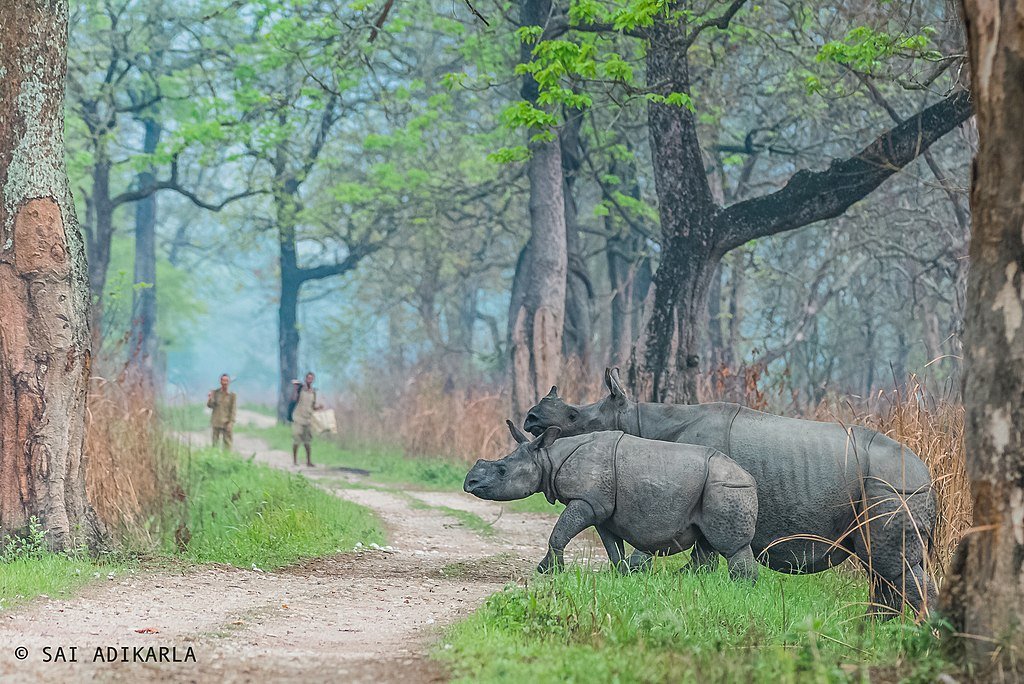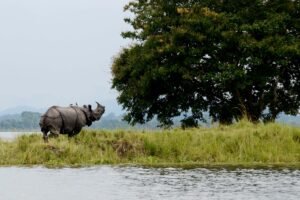
Image Credit:By Diganta Talukdar – Own work, CC BY-SA 4.0, Link
Kaziranga National Park in Assam, India, is a beautiful and strong example of nature's strength. It is known as the best place in the world to see a one-horned rhinoceros. This UNESCO World Heritage Site covers 430 square kilometers and is located between the Brahmaputra River and the Karbi Anglong Hills. The sanctuary is home to 2,613 rhinos (2022) and 148 tigers 2024. It's a place where animals can live and grow in the middle of lush grasslands and wetlands. Adventurers and nature lovers alike are drawn to Kaziranga by its elephant-back treks and the calls of rare birds. This natural beauty, shaped by yearly floods, takes you on a trip through a thriving ecosystem. Your visit helps a project that has been going on for 100 years to protect India's wild heritage. Start an adventure where every morning shows you the beauty of nature.
Kaziranga's History
In 1905, Kaziranga was first proposed as a Reserve Forest. This was in response to Mary Curzon's work to save the one-horned rhinoceros. It was first 232 square kilometers and was made a Wildlife Sanctuary in 1950. In 1968, it was made a National Park under the Assam National Park Act. In 1985, UNESCO named it a World Heritage Site. It was made a Tiger Reserve in 2006 and now has 148 tigers living in it . India's Biological Diversity Act of 2002 and the Assam (Rhinoceros) Bill of 1954 made protection stronger. Even though there are problems like poaching, Kaziranga National park success is a standard for conservation around the world. Its story, which comes from local legends, moves people all over the world.
Geography
Kaziranga National Park located between latitudes 26°30′ N and 26°45′ N, and longitudes 93°08′ E to 93°36′ E, spanning the Kaliabor subdivision of Nagaon district, Bokajan subdivision of Karbi Anglong, and Bokakhat subdivision of Golaghat district in Assam. The park measures approximately 40 km east to west and 13 km north to south, covering 378 square kilometers, with 51.14 square kilometers lost to erosion in recent years.
An additional 429 square kilometers along its boundaries has been designated as a separate national park to expand habitat and facilitate safe wildlife movement to the Karbi Anglong Hills. Elevation ranges from 40 to 80 meters, with the Brahmaputra River forming the northern and eastern boundaries, and the Mora Diphlu marking the southern edge, alongside rivers like Diphlu and Mora Dhansiri. The landscape features fertile alluvial soil from Brahmaputra silt, with 5% of the area comprising flood-formed lakes (beels) and elevated chapories, many artificially built with Indian Army support to protect animals during floods. As a biodiversity hotspot in the Indomalayan realm, Kaziranga National park includes Brahmaputra Valley semi-evergreen forests and Terai-Duar savanna grasslands, surrounded by Assam’s lush tea plantations.
Wildlife Wonders (Fauna): Meet the Residents
Kaziranga National Park is home to 2,613 one-horned rhinoceroses, the largest population in the world as of 2022. The park also supports significant populations of Indian elephants, wild water buffalo, and eastern swamp deer. The 2025 census reported 148 tigers ( 83 female, 55 males and 10 Undetermined Sex) placing Kaziranga National Park third globally in tiger density with 18.65 tigers per 100 square kilometers. Over 480 bird species have been recorded, including 43 grassland species—among them 1 Critically Endangered, 2 Endangered, and 6 Vulnerable species. Winter visitors like the lesser white-fronted goose thrive here as well. Kaziranga is home to nine primate species, including the hoolock gibbon, India’s only ape, and hosts 15 species of turtles along with king cobras and other snakes. The endangered Ganges river dolphin inhabits the park’s oxbow lakes, while leopards, sloth bears, and otters are frequently seen across the landscape. Every safari offers a rich wildlife viewing experience.

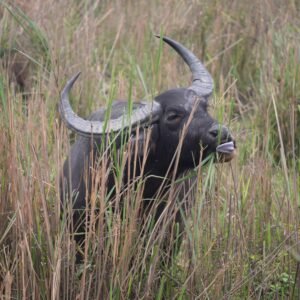

Anuwar ali hazarika, CC BY-SA 4.0, Image Source Shreya Ramakrishnan, CC BY-SA 4.0,
Vegetation and Flora( Plants)
Kaziranga National Park features four primary vegetation types: alluvial inundated grasslands, alluvial savanna woodlands, tropical moist mixed deciduous forests, and tropical semi-evergreen forests. Based on 1986 Landsat data, tall grasses cover 41%, short grasses 11%, open jungle 29%, swamps 4%, rivers and water bodies 8%, and sand 6%. The western park, at a lower altitude, is dominated by grasslands, with tall elephant grass on higher ground and short grasses near flood-formed beels. Annual floods, herbivore grazing, and controlled burning sustain these grasslands, enriched by species like sugarcane, spear grass, and common reed. Scattered trees, including kumbhi, Indian gooseberry, cotton tree, and elephant apple, provide cover. Tropical semi-evergreen forests near Kanchanjhuri, Panbari, and Tamulipathar feature trees like Aphanamixis polystachya, Talauma hodgsonii, and Dillenia indica. Deciduous forests near Baguri and Haldibari include Albizia procera, Duabanga grandiflora, and Lagerstroemia speciosa. Aquatic flora thrives in beels and along riverbanks, though invasive water hyacinth, often cleared by floods, and Mimosa invisa, removed in 2005 with Wildlife Trust of India’s help, pose challenges. This diverse vegetation supports the park’s rich biodiversity.
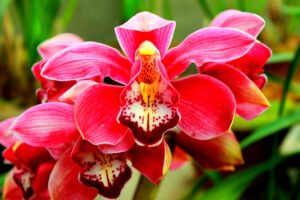
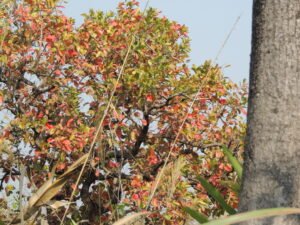
Image Credit:M.Swarnali, CC BY-SA 4.0, Image: A. J. T. Johnsingh, WWF-India and NCF, CC BY-SA 3.0,
Why Visit Kaziranga?
Kaziranga National Park is a global biodiversity hotspot, hosting over two-thirds of the world’s one-horned rhinoceros population (2,613 in 2022). Designated a UNESCO World Heritage Site in 1985, it ranks third globally for tiger density (18.65 tigers/100 sq km, 2025). Home to India’s “Big Five”—rhinos, tigers, elephants, wild water buffalo, and swamp deer—it offers thrilling wildlife encounters. The 2025 census recorded 43 grassland bird species, including the endangered Finn’s Weaver, showcasing avian richness. Visitors contribute to sustainable tourism, supporting local livelihoods and conservation efforts. Safaris through pristine grasslands and wetlands reveal a vibrant ecosystem. Your trip helps protect this ecological gem for future generations. It’s a chance to witness conservation in action. Kaziranga’s unique blend of wildlife and landscapes awaits exploration.
Landscapes and season of wonders
Kaziranga National Park's 430 square kilometers feature tall elephant grass , wetlands, tropical forests, and over 150 water bodies, shaped by Brahmaputra River floods. Winters (November–February) provide clear views after grass burning, ideal for spotting rhinos and tigers. Monsoons (June–September) transform the park into a lush, waterlogged haven, while summers (April–May) draw animals to water sources. Sunrise and sunset safaris capture misty, golden landscapes, perfect for photography. Diverse flora, like kumbhi and Indian gooseberry, enhances the park’s beauty. The 2025 bird census underscores the grasslands’ vital role in ecological balance. This dynamic landscape supports Kaziranga’s biodiversity. Seasonal changes create unique wildlife viewing opportunities.
Safari Experiences: The Wild Awaits
Jeep Safaris, departing at 8 AM and 2 PM from four zones—Central (Kohora), Eastern (Agaratoli), Western (Bagori), and Burapahar—offer diverse wildlife encounters. Elephant Safaris in Kohora and Bagori provide morning rhino sightings. The Eastern zone, is a haven for birdwatchers seeking species like Finn’s Weaver. Boat Safaris at Agaratoli showcase Ganges dolphins and riverbank birds. Observation towers provide panoramic views for spotting tigers and herds. Guided safaris ensure safety and enrich the experience. Book early for peak season to access these thrilling adventures. Kaziranga’s safaris reveal its vibrant biodiversity. Every journey iWill mmerses you in the wild.
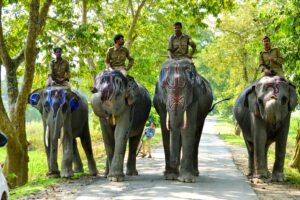
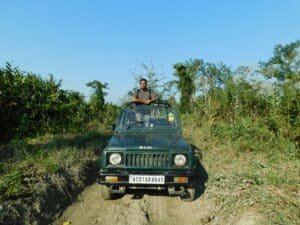
Image Credit:Lonav Bharali, CC BY-SA 4.0, Image Credit:PP Yoonus, CC BY-SA 4.0,
Visitor Guide: When and How to Visit
Kaziranga is open from October to April, with winter (November–February) offering cool, dry conditions for optimal wildlife viewing. It closes from May to October due to monsoon floods, which killed 13 rhinos in 2024. Summers (April–May) are warm, with animals near water bodies. The 2024–25 season, starting October 1, welcomed 443,636 visitors by May. Book safaris early for peak season. Pack for varying climates and adhere to park rules for a safe, eco-friendly visit. The 2025 tiger and bird censuses highlight Kaziranga’s vibrant biodiversity. Plan your trip to experience this ecological gem. Respecting guidelines ensures a memorable visit.
Places to Stay
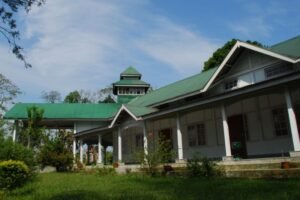
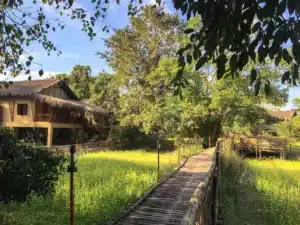
Image:Amartyabag at English Wikipedia, CC BY-SA 3.0, Image Source
Kaziranga offers government-run lodges at Kohora, private resorts like IORA and Bonhabi, and budget-friendly homestays. Resorts near park gates ensure easy safari access, while homestays provide authentic Assamese hospitality and dishes like fish curry and pithas. Packages often include park fees and safaris. The 2024–25 season saw high demand, so book early. Deluxe rooms or dormitories cater to groups, blending comfort with wilderness proximity. Enjoy local flavors while supporting the community. Accommodations enhance your Kaziranga experience. Choose options that align with your budget and preferences.
Transportation:
Jorhat Airport is 97 km away, Tezpur Airport is 100 km away, and Guwahati Airport is 217 km away. Furkating Junction is the closest rail station, 75 km away. It has connections to most of Assam's big cities. From Guwahati or Jorhat, you can take a bus or a cab to get to National Highway 37. Renting a car gives you more freedom to visit nearby sights like tea gardens. During the busy season (October–April), book your transportation ahead of time. Check the roads after the rains because the 2024 floods made them harder to get to. Near the park, you can find local auto-rickshaws.
Useful Visit Tips
Jorhat Airport is 97 km away, Tezpur Airport is 100 km away, and Guwahati Airport is 217 km away. Furkating Junction is the closest rail station, 75 km away. It has connections to most of Assam's big cities. From Guwahati or Jorhat, you can take a bus or a cab to get to National Highway 37. Renting a car gives you more freedom to visit nearby sights like tea gardens. During the busy season (October–April), book your transportation ahead of time. Check the roads after the rains because the 2024 floods made them harder to get to. Near the park, you can find local auto-rickshaws.
Outside the Park: Orchid Park and Local Culture
The Kaziranga National Orchid and Biodiversity Park in Durgapur showcases over 500 orchid species, 132 sour fruits, and 46 bamboo varieties. Enjoy seasonal Assamese folk dances and music performances. Shop for handmade textiles, reflecting Assam’s weaving traditions. Savor local cuisine, like fish tenga and pithas, at eateries or homestays. Visit Kakochang Waterfall or Numaligarh Fort for further exploration. The park’s museum highlights biodiversity, complementing Kaziranga’s wildlife with cultural immersion. These experiences enrich your visit. Assam’s heritage shines through these attractions.
Ecotourism
Kaziranga’s ecotourism thrives on wildlife observation, with birding and guided Jeep and Elephant Safaris as key activities, while hiking is banned to prevent human-animal conflicts. Observation towers at Sohola, Mihimukh, Kathpara, Foliamari, and Harmoti offer stunning views of the park’s grasslands and forests, framed by Lower Himalayan peaks. An interpretation centre at Bagori educates visitors about Kaziranga National Park's ecosystem and conservation. In 2024–25, 443,636 visitors bolstered the local economy through jobs in guiding, hospitality, and crafts.
The Assam Department of Environment and Forests manages four lodges at Kohora and three outside, with private resorts and homestays offering Assamese cuisine and cultural immersion. A 2007 survey found 80% of tourists valued rhino sightings most, with foreign visitors supporting park protection and jobs, and locals favoring veterinary services. The Kaziranga National Orchid and Biodiversity Park at Durgapur village, with 500+ orchid species, 132 sour fruits, 12 cane varieties, 46 bamboo types, and local fish, draws tourists. About 35 hotels/lodges employed ~300 people in 2007, with 26 local shops selling souvenirs and woven cloth. The Ministry of Tourism and UNDP support rural tourism at Durgapur, empowering fringe communities. Your visit sustains conservation and local livelihoods of Kaziranga National Park.
Problems in conservation and what you can do to help
It has to deal with hunting, floods (13 rhinos died in 2024), and invasive species like Mimosa. Patrols to stop poaching and the 2025 tiger census (which found 148 tigers) are signs of improvement. Your eco-friendly choices, like not using plastic and staying on paths, protect 43 kinds of grassland birds' homes. Conservation is paid for by the 443,636 tourists who came in 2024–25. Responsible travel reduces conflicts between people and animals and the loss of territory. Helping out neighborhood businesses makes communities stronger. Your visit helps keep Kaziranga National Park alive.
To Sum It Up
There are 2,613 rhinos (2022), 148 tigers , and 43 species of grassland birds living in Kaziranga. It is a live symbol of India's success in protecting wildlife. See rhinos grazing on golden fields and listen to rare birds like the Finn's Weaver. Your visit helps the people who live nearby and protects this UNESCO treasure. Kaziranga National Park is a place where you can have both fun and learn about other cultures. Come celebrate its variety with the 443,636 other people who came in 2024–25.
National Parks in India 2025 – Complete List of 107 Beautiful Parks
Sanjay Gandhi National Park – History, Overview & Highlights


